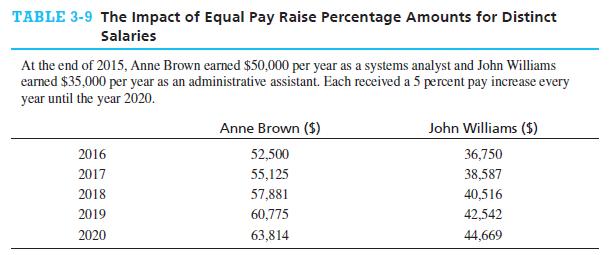We learned that merit pay increases may create a cost burden to employers because these increases carry
Question:
We learned that merit pay increases may create a cost burden to employers because these increases carry over in base pay. Refer to Table 3-9, in which Anne Brown’s annual salary is listed at the end of 2015 was $50,000 and John Williams’ was $35,000.

Questions:
1. Under a merit pay system, calculate Anne’s salary based on a 7 percent annual increase through the year 2020. For John, apply a 3 percent annual increase rate. What are their adjusted salaries for each year?
2. Let’s assume that both employees have reached the maximum pay rates for their jobs in 2015.
Under a longevity pay system, calculate the annual longevity payments for each employee through the year 2020. Using a 5 percent rate for each, what will the annual increases amount to?
What will their base pay rates be at the end of 2020?
3. Under a merit pay system scenario, let’s assume the goal is to provide Anne and John with the same annual pay increases as measured in dollars, just for 2016. It’s been determined that Anne’s annual increase rate will be 5 percent. What should the rate be for John? After applying the increase amounts, what will Anne’s and John’s new salaries be at the end of 2016?
Step by Step Answer:

Strategic Compensation A Human Resource Management Approach
ISBN: 9780134320595
9th Edition
Authors: Joseph J Martocchio





